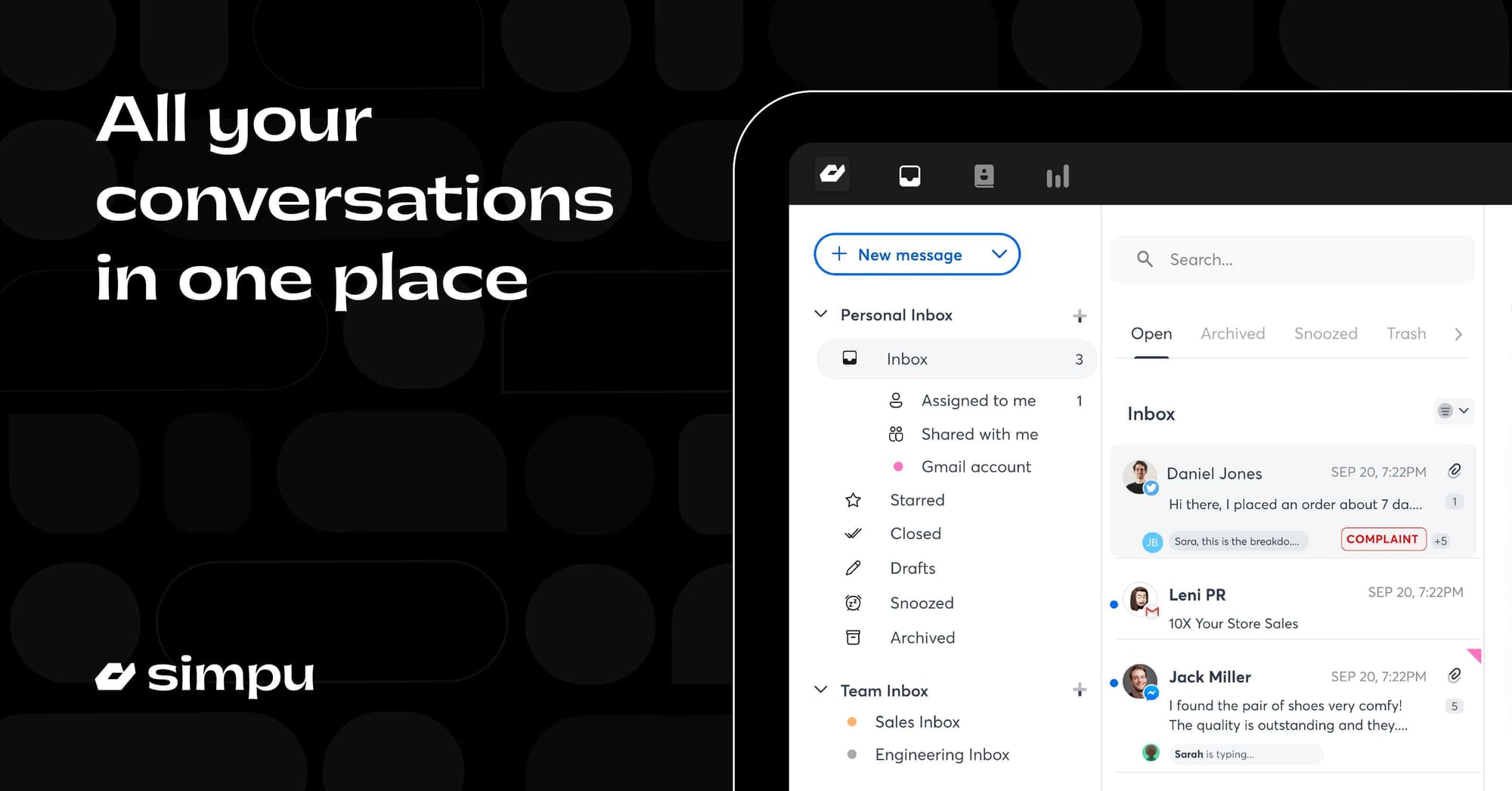Social media timelines overflow with perfectly staged ads, and influencers raving about the latest sponsored product.
But does all this truly connect with customers?
We’re currently in an era of information overload, and to pass information to an audience is harder.
But there's something that has been around forever, yet often overlooked – excellent customer service!
Yes, you read that right.
While everyone's chasing the next marketing trend, business idea, exceptional customer service is still a giant in all this - the silent driver of loyalty and business growth.
This blog dives deep into 10 expert-backed tips to transform your small business customer service, from experts that are worth paying attention to. Let’s get started.
Be specific with your small business goals.
According to 2022 data from the U.S. Bureau of Labor Statistics, about 20% of new businesses fail during their first year.

A popular small business tip for setting specific new business first goals is the SMART framework.
It ensures your goals are:
- Specific: Clearly define what you want to achieve. Avoid vague statements like "improve customer service." Instead, aim for something like "increase customer satisfaction score by 10% within the next quarter."
- Measurable: Establish a way to track your progress. Numbers are key here! You can measure goals based on sales figures, website traffic, conversion rates, customer reviews, or other relevant metrics.
- Attainable: Set ambitious yet achievable goals. Consider your resources, budget, and market realities. Don't set yourself up for failure with unrealistic targets.
- Relevant: Align your goals with your overall business strategy and objectives. Make sure they contribute to the bigger picture and focus on areas that will truly move the needle for your business.
- Time-bound: Set a clear deadline for achieving your goal. This creates a sense of urgency and helps you track progress along the way.
Examples of specific business goals for marketing and customer service may be to generate 1,000 qualified leads through social media campaigns this quarter and reduce customer churn rate by 5% within the next 6 months respectively.
“Smart goals are goals that are designed to be achievable and motivational. They are usually composed of three components; a goal, a plan, and a set of rules.” Muhammad Shehraz, Founder at Mydigitalpost.com
If your goals seem overwhelming, break them down into smaller, more manageable milestones. This will make them feel less daunting and help you track progress along the way.
Network with other small businesses.
Building a strong support network is important for any small business owner. It provides guidance, resources, and a sense of community, all essential for navigating the challenges and celebrating the successes of running your own business.

“As a young entrepreneur, I can surely say that the benefits of your networking are very crucial for your personal growth as well as business development.” - Bruno, Content Creator.
Many regions have a local small business administration that offers workshops, mentorship programs, and connections to business development resources. Consider working from a coworking space.
These shared work environments often foster a sense of community and allow you to interact with other entrepreneurs. You shouldn’t shy away from working with independent contractors.
Also, join online groups on platforms like LinkedIn or Facebook that cater to your industry or region. These groups offer a platform to share challenges, ask questions, and connect with like-minded individuals.
Automate as many things as possible.
Automation is a goldmine for many small business owners. It frees up your valuable time and resources to focus on strategic initiatives and growth while ensuring tasks are completed efficiently and consistently.

Start by analyzing your daily operations and identify repetitive, time-consuming tasks that can be automated. Research and choose automation tools that fit your specific needs and budget, it may be an accounting software.
Many affordable options cater to small businesses. Also, consider the return on investment (ROI) when automating tasks. Ensure the time and cost savings outweigh the implementation and maintenance costs.
“Small business needs to grow is scalability and optimisation. Large corporations have executive teams focusing on these key areas, and they have hundreds of staff working on them every day.” - Jonathan Kidd, Co-founder at Boombirds.
Email marketing platforms help to automate email campaigns, newsletters, and personalized outreach based on customer behaviour. Use chatbots to answer frequently asked questions, provide basic support, and route complex issues to human representatives.
A self-service knowledge base with articles, FAQs, and tutorials empowers customers to find solutions independently.
Analyze your competition in-depth.
Analyzing your competition is an important step for any small business to gain a strategic edge. Direct competitors are businesses that offer similar products or services to your target audience in your local area or niche market.

Indirect competitors may offer different products or services but can still satisfy some of your target customers' needs.
Start by brainstorming a list of both direct and indirect competitors in new markets. Research online directories, industry publications, and local listings to compile a comprehensive list.
Several online tools such as social media listening tools and SEO analysis tools can help you gather valuable competitor data.
Conduct a SWOT analysis for your business and your competitors. SWOT stands for Strengths, Weaknesses, Opportunities, and Threats.
“The first step is to choose a group of high-potential buyers aka the target market. From that group’s perspective, define the highest possible level of expectations from a quality, service, price, and other metrics standpoint. Identify possible competitors who might be serving that target market.” - Benny StaRomana, Business Strategist.
By comparing your SWOT analysis with your competitor's analysis, you can identify areas to differentiate yourself, improve your offerings, and develop strategies to gain a competitive advantage.
Understand cash flow and business expenses.
Mastering cash flow and business expenses is fundamental for successful small business owners. Cash flow refers to the movement of money in and out of your business.

It's essentially a measure of how much cash you have available to meet your financial obligations. Positive cash flow indicates you have more money coming in (revenue) than going out (expenses). Negative cash flow suggests the opposite.
“For the business to remain viable it must ensure that there is always sufficient funds available to meet the business's financial obligations, as they become due for payment.” - Peter Baskerville, Accountant.
Business expenses encompass all the costs associated with running your business. From fixed costs, variable costs, direct and indirect costs.
Address customer pain points.
As a small business owner, addressing customer pain points helps customer satisfaction and loyalty. Actively solicit feedback through surveys, email campaigns, or social media polls.

Encourage honest reviews and conduct in-person interviews with customers to gain deeper insights.
“To find a customer's pain point, it's crucial to listen attentively and empathize with their needs” - Trevor Priory, CEO @ Fortune 1000 UK Company.
Once you've identified customer pain points, delve deeper to understand the root cause of the issue. Why is this a problem for them? Not all pain points are created equal.
After implementing solutions, actively seek customer feedback to gauge their satisfaction with the changes and identify any areas for further improvement.
As your business evolves and customer needs change, so will the pain points you encounter - consider catering to this growing demand.
Regularly revisit this process to ensure you're staying ahead of customer frustrations and continuously improving the customer experience.
Leverage email and content marketing.
Boost your small business's reach and customer engagement with content and emails. Utilize high-quality content like blog posts, infographics, or videos as the foundation of your email marketing efforts.

Examples of some content ideas are industry insights, case studies, product updates and promotional offers.
“Intrusive advertisement is a lot less effective than educational content, answering questions to problems I’m realistically struggling with, and leading me through a journey I find easier to pass through than doing all of the due diligence myself. Which is why I’d rather educate and inform and let customers make their minds” - Mario Peshev, CEO at DevriX.
By strategically leveraging email and content marketing together, you can nurture leads, educate your audience, build brand loyalty, increase brand awareness and ultimately drive sales for your small business.
This powerful combination allows you to create a win-win scenario – valuable content attracts subscribers while engaging emails drive them towards consuming that content.
Provide great customer service.
Providing great customer service will keep your small business thriving. Project a warm and welcoming attitude, both in person and through interactions on calls, emails, or chats.

Pay close attention to customer concerns and requests. Show them you understand their needs through attentive listening and acknowledgement.
A successful business owner does not wait for customers to come to you with problems. If you foresee potential issues, proactively reach out and offer solutions.
Take ownership of problems and focus on finding solutions rather than making excuses or placing blame.
“Customer service and relationships are the only things you have that are unique to separate yourself from other small businesses.” - MagicBrad Gudim, Marketing Alchemist.
Make customer support accessible through phone, email, live chat, or social media for their convenience. All these will translate into increased customer loyalty, positive word-of-mouth promotion, and a thriving small business.

Build a strong team for your business.
Building a strong team is important for the success of any small business. Clearly define the roles you need within your team, outlining responsibilities, skills required, and how each role contributes to the overall business goals.

Look for cultural fit and potential beyond just the qualifications listed on a resume. Consider behavioural interview questions and skills assessments.
A diverse team with a variety of skills, experiences, and perspectives is great. This ensures creativity and a well-rounded approach to problem-solving.
“Building strong and successful teams in a business involves a combination of strategic planning, effective leadership, and fostering a positive team culture.” - Digital Uma.
Successful entrepreneurs also know how to delegate tasks and hire reliable employees. A team that is motivated, collaborative, and works together effectively can help achieve your small business goals.
Be transparent with your team and customers.
Transparency in customer service is all about being honest, open, and informative with your potential customers. It builds trust and fosters a positive relationship between your business and those you serve. Communicate policies, procedures, and timelines.

Everyone makes mistakes, but how you handle them matters. Acknowledge errors promptly, apologize sincerely, and explain how you'll rectify the situation. Don't wait for customers to come to you with problems.
“This gives the customer a positive and encouraging environment so that they will want to keep coming back. An excellent example of a servant and authentic leadership” - Elizabeth Mattke, PhD in organisational psychology.
Sometimes, customers may not understand why certain policies are in place, especially in the early stages of running an online business.
If possible, explain the reasoning behind your decisions to build trust and understanding.
Don't make promises you can't keep. Be honest about your capabilities and limitations to new customers, and set realistic expectations for what you can achieve.
FAQs you might have about running a small business.
How can I make my small business successful?
The secret to a successful small business is a strong foundation that prioritizes customers, utilizes smart marketing, and embraces adaptability.
Starting a small business can be overwhelming, focus on understanding your ideal customers and providing excellent service to turn them into loyal fans.
Build a solid business plan with financial management in mind and leverage technology to streamline operations. Develop a marketing strategy that uses a mix of channels to reach your target customers.
To build a strong team, you must adapt to changes and continuously improve your business.
What makes a small business good?
A good small business is like a friendly expert. They know their customers well and prioritize their satisfaction.
They're also smart with their money and plan for the future. This lets them adapt to change and keep growing alongside their community.
What do small business owners need most?
Many small business owners constantly fight for three things: time, money, and knowledge. They juggle a million tasks and lack the resources of bigger companies.
To succeed, they need to learn new skills fast and find support networks to help them navigate the challenges.
We've explored a range of small business tips to help you elevate your customer service game. From creating SMART goals and analyzing your competition to embracing transparency and effective communication, each tip plays a crucial role in crafting a positive customer journey.
Never focus on only marketing trends or the newest tech – the secret weapon for your small business lies in the power of exceptional customer service.
It's the magic touch that transforms one-time buyers into loyal fans, spreading positive word-of-mouth like wildfire.
With these small business tips, you're not just providing customer service – you're crafting an unforgettable experience. You're building a community of brand advocates who not only come back for more but actively recommend you to others.









